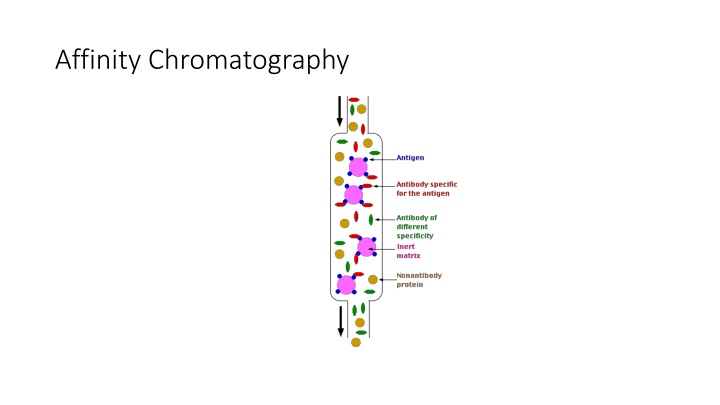
Chromatography Techniques: Affinity, Ion Exchange & Applications
Explore the principles and applications of Affinity Chromatography and Ion Exchange Chromatography. Learn about the separation mechanisms, retention volumes, and applications of GPC in natural product analysis. Discover how ion exchange resins interact with electrolyte solutions to separate ions effectively.
Download Presentation

Please find below an Image/Link to download the presentation.
The content on the website is provided AS IS for your information and personal use only. It may not be sold, licensed, or shared on other websites without obtaining consent from the author. If you encounter any issues during the download, it is possible that the publisher has removed the file from their server.
You are allowed to download the files provided on this website for personal or commercial use, subject to the condition that they are used lawfully. All files are the property of their respective owners.
The content on the website is provided AS IS for your information and personal use only. It may not be sold, licensed, or shared on other websites without obtaining consent from the author.
E N D
Presentation Transcript
Mobile phase Mobile phase is a liquid as water or dilute alcohol. Separation mechanism Based on difference between the solutes molecular weights. Molecules will distribute themselves outside & inside the pores according to their size. Larger are excluded, medium sized enter half-way & smallest permeate all the way.
The retention volume Vo of a substance is inversely proportional to the molecular weight (M. Wt) of the solute. Vo ~ 1 / M.wt Vo = retention volume M.wt = Molecular Weight
Applications of GPC to natural products Determination of M. wt. of peptides, proteins & polysaccharides. Desalting of colloids e.g. desalting of albumin prepared with 2% (NH4)2SO4. Separation of mixture of mono- & polysaccharides. Separation of amino acids from peptides & proteins. Separation of proteins of different molecular weights. Separation of mucopolysaccharides & soluble RNA. Separation of myoglobin & haemoglobin. Separation of alkaloids & purification of enzymes.
Ion Exchange Chromatography Principle Process by which ions of an electrolyte solution are brought into contact with an ion exchange resin. The ion exchange resin is an insoluble polymer consisting of a "matrix" (Lattice or framework) that carries fixed charges (not exchangeable) and mobile active ions "counter ions" which are loosely attached to the matrix. In water, the counter-ions move more or less freely in the framework & can be replaced by ions of the same sign present in the surrounding solution. The "matrix" (framework) of a "cation exchanger" is considered as a crystalline non-ionized "polyanion" & the matrix of an "anion exchanger" as a non-ionized "polycation".
Cation Exchangers Active ions (counter ions) are cations. The polar groups attached to the matrix are acidic (sulphonic acids, carboxylic acids, phenols, phosphoric acids) e.g. a cation exchanger in the free carboxylic acid form: X-COO-H+ X = Frame work (matrix) -COO-= Fixed charge (anionic), Non-exchangeable H+= Counter ion (cation), Exchangeable
They are usually (but not always) supplied in the Na+ form: X-COO-Na+ or Na + , Where = Matrix e.g. exchange with CaCl2 aqueous solution 2 Na+ + Ca++ Cl2 Ca++ +2 Na+ Cl-
Anion Exchangers Active ions (counter ions) are anions. The polar groups attached to the matrix are tertiary or quaternary ammonium groups (basic). e.g. Anion exchanger in the quaternary ammonium form: X. NR3+OH X = Framework (matrix) -NR3 += Fixed charge (cationic) Non exchangeable -OH = counter ion (anion), Exchangeable





















